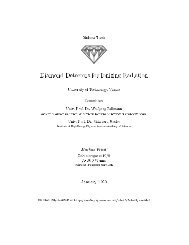You also want an ePaper? Increase the reach of your titles
YUMPU automatically turns print PDFs into web optimized ePapers that Google loves.
5 Pattern Testing for the Level-1 GlobalTrigger5.1 RequirementsErrors in the L1 GT system can be divided into two major classes: low-level errorsresulting from comparatively trivial electronics conditions such as loose connections,cross-talk from neighboring lines or short circuits, and high-level errors introducedthrough wrong cabling, incorrect configuration or implementation errors in thefirmware. It is common for both of these errors to have insidious effects that do notcause obvious malfunctions, but manifest as subtle biases in the functioning of thetrigger. Due to the trigger’s crucial importance for the functioning of the CMS experiment,it is important that such errors are identified rapidly and reliably. CMSalso employs a data quality monitoring (DQM) subsystem that should detect malfunctions.The DQM system’s approach relies on monitoring the output data streamduring physics data taking. A more preventive approach that allows verification of thesystem’s correctness before data taking starts (especially during development of newfeatures and after hardware changes) is required.Of course, the development of a system of the GT’s complexity would not have beenpossible in the absence of verification tools. While such testing was in principle understoodand possible before the present work, a test of the entire system required considerableexpertise about the internals of the hardware and manual execution of multipledisconnected software programs. To summarize, the following problems plagued theexisting system:• Testing was rare. Due to the large effort involved and expertise required, itnever became standard procedure to run a full system test regularly, or afterminor changes like cabling adjustments. This was especially true for low-levelconnection problems.• Since most actual integration testing was performed by hardware developers, adisconnect between the settings used in tests, usually performed at the developmentcrate in Vienna, and the production setup at CERN developed, making iteven more difficult to test actual production hardware.• As another consequence of this disconnect, the test data sets used did not resemblethe inputs during physics data taking. This would improve confidencethat a positive test result would imply a system according to specification.51












